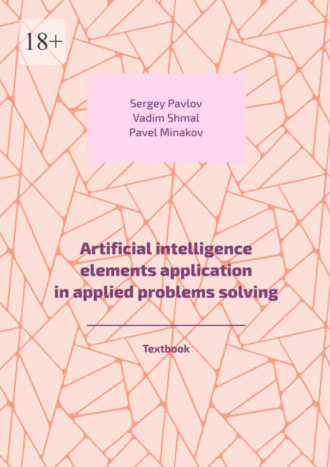
Полная версия
Artificial intelligence elements application in applied problems solving. Textbook
Most people believe that a logical model should also describe the system. However, this is often not the case. The logical model of a particular system can describe the logical relationships between constraints, but cannot describe or explain the constraints themselves. There are many ways to view the logical model. However, logical models tend to give a complete picture of the system both logically and structurally. Thus, the logical model of the system is not necessarily considered complete. The logical model describes the structural representation of the system, but provides a structural representation only for certain logical constraints. Examples of structural modeling methods include the topological method, structural decomposition, and structural decomposition and reconfiguration methods. Although structure is expressed by a structure diagram, this does not necessarily mean that the structure includes all constraints. Another type of structural modeling is the decomposition of a structure into layers of structural components. A framework can represent a logical system, business processes, and logical constraints, but it can also be expressed as constraints defined in a business process and then assigned to a logical component and logical constraints. Decomposition may be performed as part of a business process and may require the removal or modification of some or all of the constraints in the logical model. In addition, it may be necessary to modify the logical model by appropriate structural decomposition to include new structural elements. Alternatively, structural decomposition may be required to transform the logical structure into new structural elements. Decomposition and structural decomposition are processes that create new structural elements and pass them to logical constraints, but these new elements can only have the same logical constraints in the structural decomposition as the passed elements. Decomposition occurs for logical constraints that are considered complete, or for constraints whose logical representation is defined in the logical model. The process of adding constraints to a structural element requires structural decomposition, as this is where the new element is created and added. The topological method allows you to remove constraints in a structural element without changing the logical model, while structural decomposition and reconfiguration methods usually require structural decomposition as an explicit step before changing the logic. The topological method may be the most general type of structural decomposition and has the advantage of not requiring additional structural decomposition steps. For example, decomposition can be carried out in a business process component. There may be other elements in this business process that can also be included as building blocks. The decomposition can take place in a logical model or, depending on the current logical model, in a structural component, a business process component, or a topological component. If the structural decomposition is done by a topological method, this can remove more restrictions. The process of structural decomposition may include several steps, such as extracting a structural element based on a logical component representing a logical constraint. For example, a logical model representing a structure with constraints expressed as logical constraints may require a topological decomposition before the logical component structure can be modeled.
In this section, the structure of a logical component is considered as a topological decomposition of the logical structure. Topological decomposition and structural decomposition and reconfiguration methods can be used to decompose logical components in this logical structure. If a structural element and a logical component have different logical constraints, then the logical component will be created and transferred to the logical constraints during structural decomposition, but the logical element will not be placed in the logical constraints.
A logical component cannot be directly placed in a structure as a structural element. A structural element is either created or added to the topological structure from logical constraints in the topological structure. Topological decomposition and structural decomposition and reconfiguration methods can be used to create structural elements in a topological structure. The logical elements of the topological structure are placed in the topological structure by imposing structural constraints on the topological structure.
Semantic heterogeneity
Semantic heterogeneity occurs when a database schema or datasets for the same domain are developed by independent parties, resulting in differences in the meaning and interpretation of data values. To distinguish between databases and data sets with different purposes and authorship structures, metadata in different data stores is sometimes tagged with metadata tags that describe the query and collection point. This is called semantic heterogeneity.
For example, database schemas can be designed for different applications with different semantic structures, but with consistency. On the other hand, datasets and resources can be retrieved in different ways and represent different information resources. Data analytics is the process of reducing information to its most relevant essence, evaluating the relevance and interpreting various data objects and information points based on their relationship to other data.
Semantic heterogeneity plays a key role in many cases, for example:
Effective knowledge management, managing dispersed, complex and ever-changing knowledge assets.
Creation of human-centric infographics, web applications or audiovisual content in knowledge management systems.
Independently developed knowledge databases and multimedia environments (eg websites, web applications) are already used by many professionals. And now the rapidly growing Internet of Things (IoT) market is increasingly focused on improving embedded devices such as smart devices and sensors, which are sources of knowledge as well as information. And while self-organizing and self-tuning systems are increasingly found in dynamic industrial systems, the more diverse approaches of new generations of experts around the world are inspiring the creation of completely new concepts in knowledge management. This also manifests itself in the development of application-specific database approaches that are specific to each area or project.
Given the different levels of knowledge accumulation in different areas, we do not expect application-specific databases in knowledge management systems to be used for all kinds of data. Just imagine if in a data-driven knowledge management system you could only find a database or query that fits the application. This may seem in some cases too simple, and sometimes too naive. When dealing with multiple data systems for knowledge management, we expect databases or query engines of different levels of complexity to work together. This may have led to the creation of multiple databases and query engines, resulting in semantic heterogeneity.
Nowadays, as more and more databases are being developed from specific databases on the same topic, it may be necessary to define new datasets (samples) for each database or database query. Some solutions exist, such as classifying metadata fields in databases and databases for different collections. But the challenge is to use existing databases as often as possible, not create new databases for different purposes.
Another good example of semantic heterogeneity is the multitude of software platforms and data processing engines used for web services. Each platform and database has its own way of displaying data. It is important not to use different data sources for different web applications, but to find a way to reconcile different data sources with different web applications. While data sources, data management, applications and systems are heterogeneous, we need a database that provides all the data we need when different applications or systems are required. And as new platforms and databases are developed, semantic heterogeneity can be expected to remain a key feature of data analysis systems.
Data Discovery
The complexity of various databases and data engines is often hidden from the end user. In many cases, if a data user is not familiar with data sources, data management systems, and data analysis, they are likely to be unable to find the data they need. Data discovery tools used by data scientists in an enterprise provide a more consistent view of data across applications and data sources and are used to discover data sources and data management systems. Therefore, data discovery tools designed to discover data sources and data management systems must be able to integrate with all systems used to create data. In addition, any tool should be able to link the data discovery tool with other data analysis tools or data management systems.
Конец ознакомительного фрагмента.
Текст предоставлен ООО «Литрес».
Прочитайте эту книгу целиком, купив полную легальную версию на Литрес.
Безопасно оплатить книгу можно банковской картой Visa, MasterCard, Maestro, со счета мобильного телефона, с платежного терминала, в салоне МТС или Связной, через PayPal, WebMoney, Яндекс.Деньги, QIWI Кошелек, бонусными картами или другим удобным Вам способом.




